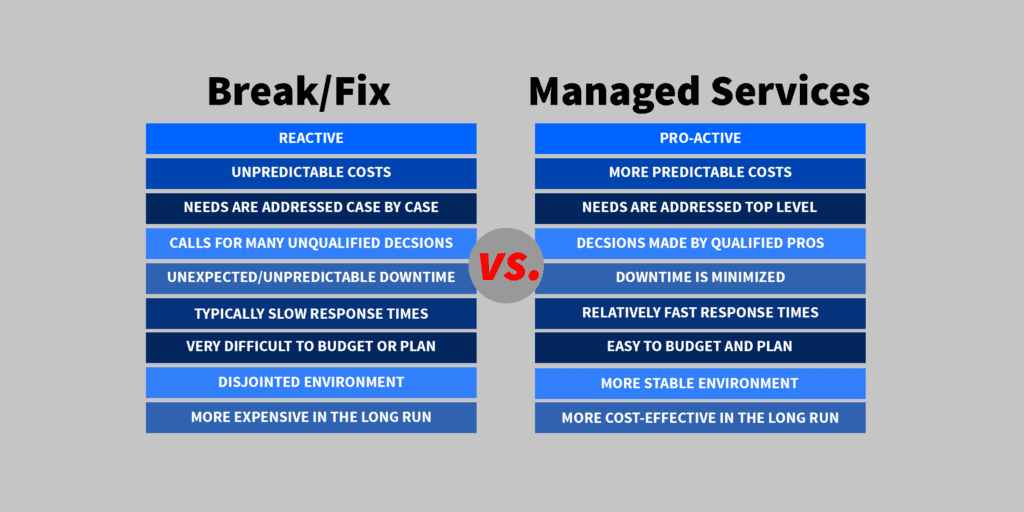Generally speaking, there are two models for addressing your IT needs, the Break/Fix Method and the Managed Service Method.
What is Break/Fix?
Break/Fix is pretty much just how it sounds. When something in your IT network breaks, you call in someone to fix it.
Many service businesses employ the Break/Fix model. When a warning light blinks on your car dashboard, you take it to the mechanic to fix it. When there’s a pipe spraying water in your basement, you call a plumber to come and fix it. When your furnace stops kicking out heat, you call an HVAC service to come and get it running again.
Break/Fix is a typical way many companies address their IT needs. If the network goes down, they call an IT specialist to come and fix it. If a computer is infected with a virus, they contact an IT provider to clean it up. If a server shuts down for no apparent reason, they call an IT guy to diagnose and recommend a course of action.
Break/Fix generally looks at your IT network as a collection of hardware and software that may or may not need to be repaired or replaced at some point. Things are not usually addressed until and unless there is a problem to fix.
What is the Managed Services Method?
Managed Service looks at your IT network as a holistic system that is continually maintained for optimum health and wellness. It’s the product of ongoing examination, planning, and upkeep designed for the specific needs of your business.
A Managed Service approach is more similar to how many medical providers approach your healthcare wherein an individualized plan is developed for your complete health that involves routine checkups, engaging in certain healthy practices, avoiding other unhealthy practices, and being proactive about your overall well-being.
Under a Managed Service approach, if a network goes down, it is quickly restored usually with remote management tools. If a computer is infected by a virus, it is swiftly addressed to protect the network it is connected to. Tools are already in place to restore any damage that is done. If a server shuts down, it’s usually not because it’s old or outdated.

How Do The Two Methods Compare in Cost?
Under the Break/Fix Model, expenses are usually incurred as needed. Typically, the client is charged on an hourly basis for the time needed to fix a problem. Often there is an additional on-site service free. And then there are the costs of replacing any equipment if necessary.
With a Managed Service Model, providers typically charge a monthly fee which is usually based on the scope of the network and the number of users involved. Most events that need attention are covered under this fee. The goal is to be pro-active and maintain the network in a healthy state at all times. Replacement equipment for repair events is usually not needed as equipment procurement is part of the overall big picture plan in place.
Which Model is more cost effective? Well…if nothing happens to your network month after month and nothing needs to be fixed, you, by definition, don’t have monthly costs. But, when something does happen, the meter starts running as you add up the expense of calling someone in to fix the issue, the downtime involved, and any equipment needed. The costs are pretty much unknown and open-ended for each event.
A Managed Services Model brings you the predictable costs of a monthly fee. When and if something does happen, it’s usually much more manageable and costs are contained.
46 percent of firms reduced their annual IT expenditures by at least 25 percent by going with a Managed Service Provider (MSP). — CompTIA Annual Trends in Managed Services Report.
As any business owner can tell you (and any dentist or doctor or auto repair mechanic) remediation is always more expensive than prevention. Changing your oil on a regular basis is much less expensive than replacing an engine that’s never had its oil changed.
A recent study conducted by CompTIA called the ‘Annual Trends in Managed Services’ Report reveals that among current users of managed services, 46 percent of firms reduced their annual IT expenditures by at least 25 percent by going with a Managed Service Provider (MSP). An additional 50 percent of organizations saved between 1 percent and 24 percent in overall IT costs annually. The report confirms the role of MSPs play in reducing IT costs.
Business Relationships Work Better When Both Sides Win
The other issue with the two models is the core business relationship they create between the customer and the service provider.
One of the inherent problems with the Break/Fix Model is that it creates a rather negative business relationship. The customer wins when he never needs service. If he does need service, he can be resistant to calling for help, he may try to fix things himself, or he may hope to hold on until a later date. The situation usually only gets worse.
The service provider, on the other hand, only wins when there are problems to fix, so there is little incentive to do anything to keep that from happening. Ultimately the customer loses trying to avoid problems and the service provider loses until there is a problem. The relationship is situational. You usually only see each other when there is something wrong, and it may not be the same person twice.
A Managed Services Model creates a much more positive business relationship. The managed service provider works to understand your business and its unique needs. Most Managed Services providers seek to be valued part of your business team, much like a banker, lawyer, or insurance agent. The customer gains peace of mind that his systems will be continually up and running. He doesn’t need to worry about emergencies and dealing with fire drills. He can predict costs and manage accordingly. The service provider on the other hand has incentive to keep the client’s systems up and running and the customer happy. He is rewarded with a predictable monthly income. Both sides win.

